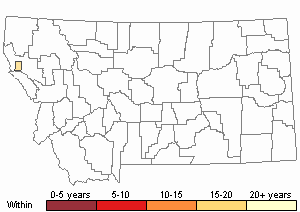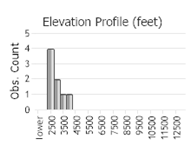View in other NatureServe Network Field Guides
NatureServe
Montana
Utah
Wyoming
Idaho
Wisconsin
British Columbia
South Carolina
Yukon
California
New York
Spring Field Cricket - Gryllus veletis
General Description
The following comes from Severin (1935), Alexander and Bigelow (1960), Helfer (1971), Capinera and Sechrist (1982), Vickery and Kevan (1985), Capinera (2001), Bland (2003), Capinera et al. (2004), Elliot and Hershberger (2007), Himmelman (2009), Scott (2010), and Weissman and Gray (2019). Both the Spring Field Cricket and
Fall Field Cricket (
Gryllus pennsylvanicus) are basically indistinguishable in morphology, color, song and were once thought to be the same species,
Gryllus assimilis (as reported by Hebard (1928) and Severin (1935)). Also, the older genus name
Acheta will be used in some literature prior to 1960. When field studies revealed that they are two separate species due to their evolutionary development barrier known as “allochronic,” a mode of speciation of species living, growing, or reproducing at different times of the year (see Phenology below). These two barrel-shaped species are shiny black or dark brown with no markings. Their heads are slightly wider than their bodies and the wings (tegmina), and can be either black or light brown. Females are distinguished from males by their long, spear-like ovipositors which are split at the tip.
Calling song stridulation: The song of both species is described as “a series of clear, loud chirps given at a rate of about one to four per second depending upon ambient temperature.” They sing both day and night. There is little, if any, detectable difference in their stridulation. Sound is produced by raising the wings and rubbing them together, which draws the wings' teeth of scrapers and files, the sound-making mechanism, across each other. Their auditory receptors (ears) are located at the knee on the tibia of the front legs. Through recorded sonograms, researchers have recognized 6 functional songs in the reproductive behavior of these species: (1) The Calling Song, (2) The Courtship Song, (3) The Aggression Sound, (4) The Courtship Interruption Sound, (5) The Post-copulatory Sound, and (6) The Recognition Sound. Refer to Alexander (1966), Huber and Thorson (1985), Alexander and Meral (1967), Walker and Carlysle (1975), and Masaki et al. (1987) for the details of cricket acoustical communication.
Calculating temperature F: (#1) Tf=50 + Number of chirps/minute – 40 ÷ 4. Or use a simpler formula:(#2) Tf=4 + Number of chirps/15 seconds. Crickets generally do not sing at temperatures below 55 degrees F or above 100 degrees F. The original (#1) formula was published by Alfred Dolbear (1897), Tufts College, and became known as “Dolbear’s Law.”
Phenology
The following is taken from Alexander and Bigelow (1960), Capinera (2001), Capinera and Sechrist (1982), Capinera et al. (2004), Elliot and Hershberger (2007), Himmelman (2009), Scott (2010), Vickery and Kevan (1985), and Weissman and Gray (2019). The Spring Field Cricket overwinters (diapause) as mid-sized nymphs. They mature quickly and adults begin singing and mating in late spring (April to May) continuing on into early July, when they die. The
Fall Field Cricket (
Gryllus pennsylvanicus) overwinters (diapause) in the egg stage and adults begin singing in late July or early August and continue on into the fall or the first killing frost. Where these two species overlap in occurrence and habitat, there is usually a period of silence in mid-summer (July) when no cricket songs are heard since
G. veletis is dying out and
G. pennsylvanicus is maturing. These differences in overwintering diapause and adult singing occurrence have been recognized by researchers for decades past when these species were considered races of
G. assimilis.
Diagnostic Characteristics
The following comes from Bland (2003), Helfer (1971), Capinera and Sechrist (1982), Vickery and Kevan (1985), Capinera (2001), Bland (2003), Capinera et al. (2004), Elliot and Hershberger (2007), Himmelman (2009), Scott (2010) and Weissman and Gray (2019). Adult body length for both species, males and females, can range from 13 mm to 34 mm. The field crickets are highly variable in their morphology and there are many papers in the literature focused on the subject. Body size tends to vary with latitudinal distribution of individuals, with smaller crickets occurring in the more northern areas. The female ovipositor is often slightly longer in
G. pennsylvanicus than
G. veletis.
Could be confused with the Ground Crickets,
Allonemobius spp., and the House Cricket,
Acheta domesticus which is an Old-World species imported into North America in the 1700’s via shipping. It can now be found throughout the continent since it is commonly reared on “cricket farms” and sold in pet shops for food, bait shops and in laboratories for biological research. Escaped feral populations occur across the eastern and central states (except Florida) and southern California. To date, no feral House Crickets have been recorded in the field for the western half of the country nor in Montana (Capinera et al. 2004).
Species Range
Montana Range
Range Descriptions

 Native
Native
Range Comments
The Spring Field Cricket, G. veletis, is broadly distributed across North America from the east coast to the west coast, but is absent over much of the west and plains states south of Washington, Montana, and the Dakotas. From the mid-West to the east coast, it extends only southward to mid-Arkansas, Tennessee, and northwest North Carolina. In Montana, it has been reported in five counties. It is probably more wide-spread in the state than currently known (Bland 2003, Capinera et al. 2004, Scott 2010, and Weissman and Gray 2019).
Observations in Montana Natural Heritage Program Database
Number of Observations: 17
(Click on the following maps and charts to see full sized version)
Map Help and Descriptions
Relative Density

Recency



 (Observations spanning multiple months or years are excluded from time charts)
(Observations spanning multiple months or years are excluded from time charts)
Habitat
The Spring Field Cricket favors ground debris, rock piles, under shrubs and in burrows. It tends to be more solitary, sedentary, aggressive, and burrow-inhabiting and is rarely as numerous as the The
Fall Field Cricket (Bland 2003, Capinera et al. 2004, and Vickery and Kevan 1985).
Food Habits
These crickets’ diets are varied and considered omnivorous, consuming leafy plant matter, roots, flowers, fruits, and seeds. They also eat dead insects and are reported to be cannibalistic. Sometimes these crickets’ nymphs and adults exhibit predatory behavior, consuming grasshopper eggs, pupa of flies and caterpillars, flea beetles, and insects from spider webs. They also invade homes and are documented to gnaw on such products as fur, wool, linen, cotton and paper products. They are generally not considered a serious pest unless they are abundant, and this usually occurs with the
Fall Field Cricket (
Gryllus pennsylvanicus), which is more gregarious, abundant and widely distributed than the Spring Field Cricket,
G. veletis (Bland 2003, Capinera 2001, and Severin 1935).
Reproductive Characteristics
These species have one generation per year and pass through 8-9 nymphal instars before reaching the adult stage. Adults generally live for 8 to 10 weeks. Eggs are laid in firm, damp soil about 0.8 inches below the surface. The eggs are about 3 mm long, cylindrical, slightly bent with rounded ends and light yellow or cream colored. The color changes and the shape enlarges as the embryo develops. A female may lay a range of 150-400 eggs, deposited singly, but several may be in close proximate clusters. Except for the overwinter eggs of
Gryllus pennsylvanicus, the eggs hatch in about two weeks. Upon hatching, in both species, the nymphs pass through 8 to 9 instars before reaching the adult stage (Bland 2003, Capinera 2001, and Severin 1935).
Stewardship Responsibility
References
- Literature Cited AboveLegend:
 View Online Publication
View Online Publication Alexander, R.D. 1966. The evolution of cricket chirps. Natural History 75(9):26-31.
Alexander, R.D. 1966. The evolution of cricket chirps. Natural History 75(9):26-31. Alexander, R.D. and G.H. Meral. 1967. Seasonal and daily chirping cycles in the northern spring and fall field crickets, Gryllus veletis and G. pennsylvanicus. The Ohio Journal of Science 67(4):200-209.
Alexander, R.D. and G.H. Meral. 1967. Seasonal and daily chirping cycles in the northern spring and fall field crickets, Gryllus veletis and G. pennsylvanicus. The Ohio Journal of Science 67(4):200-209. Alexander, R.D. and R.S. Bigelow. 1960. Allochronic speciation in field crickets, and a new species, Acheta veletis. Evolution 14:334-346.
Alexander, R.D. and R.S. Bigelow. 1960. Allochronic speciation in field crickets, and a new species, Acheta veletis. Evolution 14:334-346. Bland, R.G. 2003. The Orthoptera of Michigan—Biology, Keys, and Descriptions of Grasshoppers, Katydids, and Crickets. East Lansing, MI: Michigan State University Extension, Bulletin E-2815. 221 p.
Bland, R.G. 2003. The Orthoptera of Michigan—Biology, Keys, and Descriptions of Grasshoppers, Katydids, and Crickets. East Lansing, MI: Michigan State University Extension, Bulletin E-2815. 221 p. Capinera, J.L. 2001. Handbook of vegetable pests. Orlando, FL: Academic Press. 800 p.
Capinera, J.L. 2001. Handbook of vegetable pests. Orlando, FL: Academic Press. 800 p. Capinera, J.L. and T.S. Sechrist. 1982. Grasshoppers of Colorado: Identification, Biology, and Management. Fort Collins, CO: Colorado State University Experiment Station, Bulletin 584S. 161 p.
Capinera, J.L. and T.S. Sechrist. 1982. Grasshoppers of Colorado: Identification, Biology, and Management. Fort Collins, CO: Colorado State University Experiment Station, Bulletin 584S. 161 p. Capinera, J.L., R.D. Scott, and T.J. Walker. 2004. Field Guide to Grasshoppers, Katydids, and Crickets of the United States. Ithaca, NY. Cornell University Press.
Capinera, J.L., R.D. Scott, and T.J. Walker. 2004. Field Guide to Grasshoppers, Katydids, and Crickets of the United States. Ithaca, NY. Cornell University Press. Elliott, L. and W. Hershberger. 2007. The songs of insects. New York, NY: Houghton Mifflin Harcourt. 227 p.
Elliott, L. and W. Hershberger. 2007. The songs of insects. New York, NY: Houghton Mifflin Harcourt. 227 p. Helfer, J.R. 1971. How to Know the Grasshoppers, Crickets, Cockroaches, and Their Allies. Revised edition (out of print), Mineola, NY: Dover Publications.
Helfer, J.R. 1971. How to Know the Grasshoppers, Crickets, Cockroaches, and Their Allies. Revised edition (out of print), Mineola, NY: Dover Publications. Himmelman, J. 2009. Guide to Night-Singing Insects of the Northeast. Mechanicsburg, PA: Stackpole Books. 160 p.
Himmelman, J. 2009. Guide to Night-Singing Insects of the Northeast. Mechanicsburg, PA: Stackpole Books. 160 p. Huber, F. and J. Thorson. 1985. Cricket auditory communication. Scientific American 253(6):60-73.
Huber, F. and J. Thorson. 1985. Cricket auditory communication. Scientific American 253(6):60-73. Masaki, S., M. Kataoka, K. Shirato, and M. Nakagahara. 1987. Evolutionary differentiation of right and left tegmina in crickets. pp. 347-357 In: B.M. Baccetti (ed.). Evolutionary Biology of Orthopteroid Insects. New York, NY: John Wiley & Sons.
Masaki, S., M. Kataoka, K. Shirato, and M. Nakagahara. 1987. Evolutionary differentiation of right and left tegmina in crickets. pp. 347-357 In: B.M. Baccetti (ed.). Evolutionary Biology of Orthopteroid Insects. New York, NY: John Wiley & Sons. Scott, R.D. 2010. Montana Grasshoppers, Katydids, and Crickets A Pictorial Field Guide to the Orthoptera. MagpieMTGraphics, Billings, MT.
Scott, R.D. 2010. Montana Grasshoppers, Katydids, and Crickets A Pictorial Field Guide to the Orthoptera. MagpieMTGraphics, Billings, MT. Severin, H.C. 1935. The common black field cricket: a serious pest in South Dakota. Brookings, SD: South Dakota State Universtiy Agricultural Experiment Station Bulletin 295. 52p.
Severin, H.C. 1935. The common black field cricket: a serious pest in South Dakota. Brookings, SD: South Dakota State Universtiy Agricultural Experiment Station Bulletin 295. 52p. Vickery, V. R. and D. K. M. Kevan. 1985. The grasshopper, crickets, and related insects of Canada and adjacent regions. Biosystematics Research Institute, Ottawa, Ontario. Publication Number 1777. 918 pp.
Vickery, V. R. and D. K. M. Kevan. 1985. The grasshopper, crickets, and related insects of Canada and adjacent regions. Biosystematics Research Institute, Ottawa, Ontario. Publication Number 1777. 918 pp. Walker, T.J. and T.C. Carlysle. 1975. Stridulatory file teeth in crickets: taxonomic and acoustic implications (Orthoptera: Gryllidae). International Journal of Insect morphology and Embryology 4(2):151-158.
Walker, T.J. and T.C. Carlysle. 1975. Stridulatory file teeth in crickets: taxonomic and acoustic implications (Orthoptera: Gryllidae). International Journal of Insect morphology and Embryology 4(2):151-158. Weissman, D.B. and D.A. Gray. 2019. Crickets of the genus Gryllus in the United States (Orthoptera: Gryllidae: Gryllinae). Zootaxa 4705(1): 1-277.
Weissman, D.B. and D.A. Gray. 2019. Crickets of the genus Gryllus in the United States (Orthoptera: Gryllidae: Gryllinae). Zootaxa 4705(1): 1-277.
- Additional ReferencesLegend:
 View Online Publication
View Online Publication
Do you know of a citation we're missing? Alexander, R.D. 1962. Evolutionary change in cricket acoustical communication. Evolution 16:443-467.
Alexander, R.D. 1962. Evolutionary change in cricket acoustical communication. Evolution 16:443-467. Alexander, R.D. 1962. The role of behavioral study in cricket classification. Systematic Zoology 11(2):53-72.
Alexander, R.D. 1962. The role of behavioral study in cricket classification. Systematic Zoology 11(2):53-72. Alexander, R.D. 1968. Life cycle origins, speciation, and related phenomena in crickets. The Quarterly Review of Biology 43(1):1-42.
Alexander, R.D. 1968. Life cycle origins, speciation, and related phenomena in crickets. The Quarterly Review of Biology 43(1):1-42. Alexander, R.D. and D. Otte. 1967. The evolution of genitalia and mating behavior in crickets (Gryllidae) and other Orthoptera. Ann Arbor, MI: University of Michigan. Misc. publications, Museum of Zoology, No. 133. 69 p.
Alexander, R.D. and D. Otte. 1967. The evolution of genitalia and mating behavior in crickets (Gryllidae) and other Orthoptera. Ann Arbor, MI: University of Michigan. Misc. publications, Museum of Zoology, No. 133. 69 p. Dethier, V.G. 1992. Crickets and Katydids, Concerts and Solos. Cambridge, MA: Harvard University Press. 140 p.
Dethier, V.G. 1992. Crickets and Katydids, Concerts and Solos. Cambridge, MA: Harvard University Press. 140 p. French, W.B. and W.H. Cade. 1987. The timing of calling, movement and mating in field crickets, Gryllus veletis, G. pennsylvanicus, and G. integer. Behavioral Ecology and Sociobiology 21:157-162.
French, W.B. and W.H. Cade. 1987. The timing of calling, movement and mating in field crickets, Gryllus veletis, G. pennsylvanicus, and G. integer. Behavioral Ecology and Sociobiology 21:157-162. Himmelman, J. 2011. Cricket radio: tuning in the night-singing insects. Cambridge, MA: The Belknap Press of Harvard University Press. 272 p.
Himmelman, J. 2011. Cricket radio: tuning in the night-singing insects. Cambridge, MA: The Belknap Press of Harvard University Press. 272 p. Sater, S. 2022. The insects of Sevenmile Creek, a pictorial guide to their diversity and ecology. Undergraduate Thesis. Helena, MT: Carroll College. 242 p.
Sater, S. 2022. The insects of Sevenmile Creek, a pictorial guide to their diversity and ecology. Undergraduate Thesis. Helena, MT: Carroll College. 242 p. Walker T.J.(ed.). 2020. Singing insects of North America. Accessed 10 February 2021. https://orthsoc.org/sina/
Walker T.J.(ed.). 2020. Singing insects of North America. Accessed 10 February 2021. https://orthsoc.org/sina/ Walker, T.J. and S. Masaki. 1989. Natural History. pp. 1-43. In: F. Huber, T.E. Moore, and W. Loher (eds). Cricket Behavior and Neurobiology. Ithaca, NY: Cornell University Press. 536 p.
Walker, T.J. and S. Masaki. 1989. Natural History. pp. 1-43. In: F. Huber, T.E. Moore, and W. Loher (eds). Cricket Behavior and Neurobiology. Ithaca, NY: Cornell University Press. 536 p.
- Web Search Engines for Articles on "Spring Field Cricket"
- Additional Sources of Information Related to "Insects"





